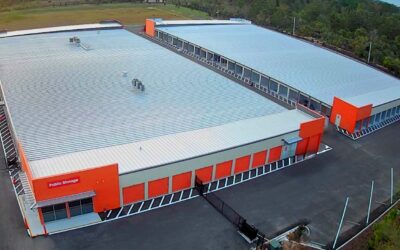The self storage industry has operated in the same manner for a long time and not much new innovation has triggered the consumer to stop and take notice.
Until recently.
We know that the self-storage industry is a fragmented business with some 50,000 facilities in the United States. Self-storage continues to show tremendous resiliency and growth with very little infrastructure change.
But is all that about to change?
Slowly but surely we are beginning to see that technology with smartphone integration has provided another avenue for convenience that has sparked the interest of consumers.
On demand storage, full-service storage or valet storage companies (whatever you choose to call them) provide technology and convenience that are causing some customers to think twice about their storage options. How much tension will the on demand storage concept put on traditional storage or will this new trend be a passing phase?
Sitting in traffic on the 405 Freeway in Southern California and seeing huge billboards for MakeSpace makes one wonder. They are based in New York and over the last few years have expanded to Los Angeles and other markets. The consumer of today is faced with new storage options that were never before available.
How it used to be.
The modern day consumer typically begins their search for storage sitting at the computer (or increasingly holding their smartphone) and they use Google to search for storage near their location. This approach to finding storage hasn’t changed much since the advent of Google. You know as a consumer that there are facilities everywhere. Storage is storage and you need space.
So you choose a facility from the results page and make a reservation. You pack your stuff and drive to that location near your house. You choose the size and price. It is a straight forward, no-nonsense storage rental process, you pack it, haul it and drive it yourself. And you can visit your items any time you choose, you have the lock and key.
But now you have another new option.
Instead of buying boxes and lugging your stuff (and begging your friends to help), you can instead pack your stuff in bins provided by this new type of storage provider. No boxes for you to buy. Additionally, there is an app for your phone that keeps an inventory of everything you are storing away. The company sends employees to pick up and deliver your stuff back to you whenever you want it. You don’t do much but prepare it all for hauling out of your home and into their facility. Done!
Both options have the same end result.
Bottom line: it is all about storing your excess items that are in your way and getting it out of your sight—until further notice.
However this new model is a bit more convenient. You may be moving; downsizing or remodeling, at a particular stage in your life—the same storage lifecycle that has been cited as an industry statistic for decades. So as the consumer you hesitate because you never realized that now there is a new easier process to complete your task.
So you ponder it, and ask which rental consumer am I?
Now you need to make a final decision that in the past has been obvious and typically a no-brainer. When you return to search “self-storage” a second time, this time a targeted advertisement is displayed for you to read and click through. This ad is telling you that traditional storage is stupid. The ad also reminds you that you are too busy to haul your own items to a facility and your time is too precious. This raises some very good points so you dig deeper into what those new companies with catchy names have to offer.
MakeSpace, Closetbox and Clutter are a few that pop up as you begin to research the “new” way to store. Now you are asking yourself what can they offer me? Is it cheaper? More convenient? Less hassle?
Some options that they have (and traditional storage doesn’t) are very appealing: Free pick up, provided boxes or bins, a handy app, and scheduled delivery to your home.
Free pick up sounds very tantalizing and they even pick up that old heavy couch and armoire. And you love the idea of not having to buy a bundle of boxes. This can save money and a tree. Don’t forget that also being able to see what I put in my bin or container from my app is very sexy and cool too.
It then magically all gets picked up, no sweat for me or hassle. How can this not be fantastic, these storage companies store it all in a warehouse on the outskirts of town, so therefore rent has got to be cheaper. Right?!
Well not so fast.
When you calculate and compare, you find that their rental pricing rates are not so different. Here is why. This pick up, carry and storage business is very labor intense. There is a price for all that convenience and technology, and that means storing for a minimum term of two or three months.
Scheduling a drop off of your items to your home requires lots of manpower and flexibility, and there is typically a fee charged at the time of delivery. But for many consumers the price comparisons will not discourage nor deflect.
In an article about Clutter, Fortune Magazine explains why full-service storage is just a response to the changing preferences of younger consumers:
These days, you can hire people to deliver your food, laundry, and even park your car by merely tapping a button on your mobile phone.
Realistically there is room for both.
The self-storage customer is diverse and has many different needs. Traditional storage historically has weathered all the storms of the economy, good and bad, and for that reason both types of potential customers can play a role.
On demand storage with technology and convenience won’t ever kill the self-storage industry. It will just make the overall storage industry more competitive and scalable.
There is obviously room for more storage if Clutter and others like them continue to raise funds. Traditional self-storage operators large and small will always play a role in the future of this industry. People will continue to accumulate possessions. How they choose storage would depend on their point of reference and desire. Young city dwellers could be their niche.
Consumers that thrive on technology and the convenience that a push of a button provides will always participate in a new approach that puts all the work into someone else’s hands. This consumer will find satisfaction in storage on demand and all the convenience it provides. Choices will be based on technology and some will not. On demand appeals to a specific type of consumer and traditional storage appeals to another.
Don’t forget many consumers will not ever give up the “control” and will always want the lock and key.







